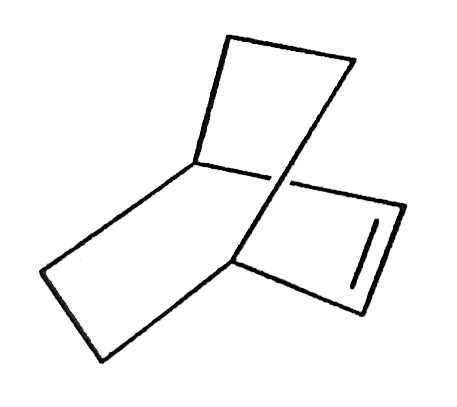PhCOOH(A)(i)N2H,H⊕−−−−−−−−→(ii)Δ(B)H2O/ӨOH−−−−−→(C)
Which of the following statement is /are correct about the reaction ?
The compounds (B) and (C), respectively, are Ph−N=C=O and PhNH2.
The compounds (B) and (C), respectively, are Ph⊕N≡ӨC and PhNHMe.
The reaction is known as Curtius rearrangement reaction.
The reaction is known as Schmidt rearrangement reaction.
The correct Answer is:A, D
To analyze the reaction provided in the question, we will break it down step by step, focusing on the transformation of benzoic acid (PhCOOH) through the specified reactions.
Step 1: Identify the Reactants
The starting compound is benzoic acid (PhCOOH).
Step 2: First Reaction with N2H4 in Acidic Medium
In the first step, benzoic acid reacts with hydrazine (N2H4) in an acidic medium (H⁺). This reaction typically leads to the formation of a hydrazone derivative. The hydroxyl group (OH) from the carboxylic acid and a hydrogen (H) from hydrazine combine to form water (H2O), resulting in the formation of a new compound.
Formation of Compound B:
- The reaction can be summarized as:
PhCOOH+N2H4H+−−→Compound B
Step 3: Heating the Product
Next, the product (Compound B) is heated. During this step, a rearrangement occurs where nitrogen leaves the structure, potentially leading to the formation of an intermediate compound.
Step 4: Rearrangement Reaction
The rearrangement that occurs is known as the Claisen-Bischoff rearrangement. In this reaction, the phenyl group (Ph) attacks the nitrogen, leading to the formation of a new compound.
Formation of Compound C:
- The reaction can be summarized as:
Compound BΔ−→Compound C
Step 5: Reaction with Water in Basic Medium
Finally, Compound C is treated with water in a basic medium (OH⁻). This leads to the hydrolysis of the compound, resulting in the formation of aniline (PhNH2) and the release of carbon dioxide (CO2).
Conclusion
The final products of the reaction sequence are:
- Compound B: An intermediate formed after the first reaction.
- Compound C: Aniline (PhNH2).
Summary of Statements
1. Statement A: Correct, as it describes the formation of Compound B and C accurately.
2. Statement B: Incorrect, as it mentions wrong products.
Final Answer
The correct answer will be the statements that accurately describe the reaction and products formed.
---
The starting compound is benzoic acid (PhCOOH).
In the first step, benzoic acid reacts with hydrazine (N2H4) in an acidic medium (H⁺). This reaction typically leads to the formation of a hydrazone derivative. The hydroxyl group (OH) from the carboxylic acid and a hydrogen (H) from hydrazine combine to form water (H2O), resulting in the formation of a new compound.
- The reaction can be summarized as:
PhCOOH+N2H4H+−−→Compound B
Next, the product (Compound B) is heated. During this step, a rearrangement occurs where nitrogen leaves the structure, potentially leading to the formation of an intermediate compound.
The rearrangement that occurs is known as the Claisen-Bischoff rearrangement. In this reaction, the phenyl group (Ph) attacks the nitrogen, leading to the formation of a new compound.
- The reaction can be summarized as:
Compound BΔ−→Compound C
Finally, Compound C is treated with water in a basic medium (OH⁻). This leads to the hydrolysis of the compound, resulting in the formation of aniline (PhNH2) and the release of carbon dioxide (CO2).
The final products of the reaction sequence are:
- Compound B: An intermediate formed after the first reaction.
- Compound C: Aniline (PhNH2).
1. Statement A: Correct, as it describes the formation of Compound B and C accurately.
2. Statement B: Incorrect, as it mentions wrong products.
The correct answer will be the statements that accurately describe the reaction and products formed.
Topper's Solved these Questions
- CARBOXYLIC ACIDS AND THEIR DERIVATIVESBOOK - CENGAGE CHEMISTRY ENGLISHCHAPTER - CARBOXYLIC ACIDS AND THEIR DERIVATIVESEXERCISE - Exercises (Singlecorrect)
64 Videos
- CARBOXYLIC ACIDS AND THEIR DERIVATIVESBOOK - CENGAGE CHEMISTRY ENGLISHCHAPTER - CARBOXYLIC ACIDS AND THEIR DERIVATIVESEXERCISE - Exercises (Assertion-Reasoning)
10 Videos
- CARBOXYLIC ACIDS AND THEIR DERIVATIVESBOOK - CENGAGE CHEMISTRY ENGLISHCHAPTER - CARBOXYLIC ACIDS AND THEIR DERIVATIVESEXERCISE - Exercises (Linked Comprehension)
34 Videos
- BIOMOLECULESBOOK - CENGAGE CHEMISTRY ENGLISHCHAPTER - BIOMOLECULESEXERCISE - Exercises Archives (Analytical And Descriptive)
8 Videos
- CHEMICAL KINETICSBOOK - CENGAGE CHEMISTRY ENGLISHCHAPTER - CHEMICAL KINETICSEXERCISE - Archives Subjective
23 Videos
Similar Questions
EtCOCl(A)(i)H2N.OH−−−−−−−→(ii)ӨOH(B)EtOH−−−→(C)
Which of the following statements are correct about the given reaction ?
View SolutionMeCH2COOH(A)(i)SOCI−−−−−−−→(ii)CH2N2(iii)Ag2O/Pt(B)H2O−−→(C)
Which of the following statements are correct about the given reaction.
View SolutionMeCOOEt(i)NH2NH2−−−−−−−→(ii)HNO2(iii)ΘOH(B)−−−→MeOH(C)
Which of the following statements are correct about the given reaction?
View SolutionPhCOOMe(A)(i)NH2OH−−−−−−−−−→(ii)ӨOH(iii)EtOH(B)
Product (B) is :
View SolutionConsider the following reactions :
(I)Me−≡(A)−MeH2+−−−−−−→Pd+BaSO4?(B)D2/Pd/C−−−−−−→(C)
(II)Me−≡(A)−MeNa+Liq.NH3−−−−−−−−→+EtOH?(D)D2/Pt/C−−−−−→(E)
Which of the following statements are correct ?
View SolutionConsider the folliwng reactions:
I. Me3C−BrH2O+NaBr−−−−−−−−−→SN1Product
II. Ph3C−BrH2O+NaBr−−−−−−−−−→SN1Products
Which of the folliwng statements are correct about the above reactions?
View SolutionPhenol (i) NaOH−−−−→(ii) CO2(A)H+/H2O−−−−−→(B)Ac2O−−→(C)
In this reaction , identify the incorrect statement?
View SolutionEtCOOMe(A)(i)NH2NH2(ii)HNO2−−−−−−−−−−−−→(iii)ӨOH(iv)H3O⊕(B)
The product (B) is :
View Solution (i)O3−−−−−−−−→(ii)Zn−H2O¯:OH−−→Δ NO. of aldol condensation product.
(i)O3−−−−−−−−→(ii)Zn−H2O¯:OH−−→Δ NO. of aldol condensation product.
View SolutionPh−Me∣C∣H−OHSOCl2−−−−−→inC5H5N, Which statement is true for the above reaction?
View Solution
